Address
304 North Cardinal St.
Dorchester Center, MA 02124
Work Hours
Monday to Friday: 7AM - 7PM
Weekend: 10AM - 5PM
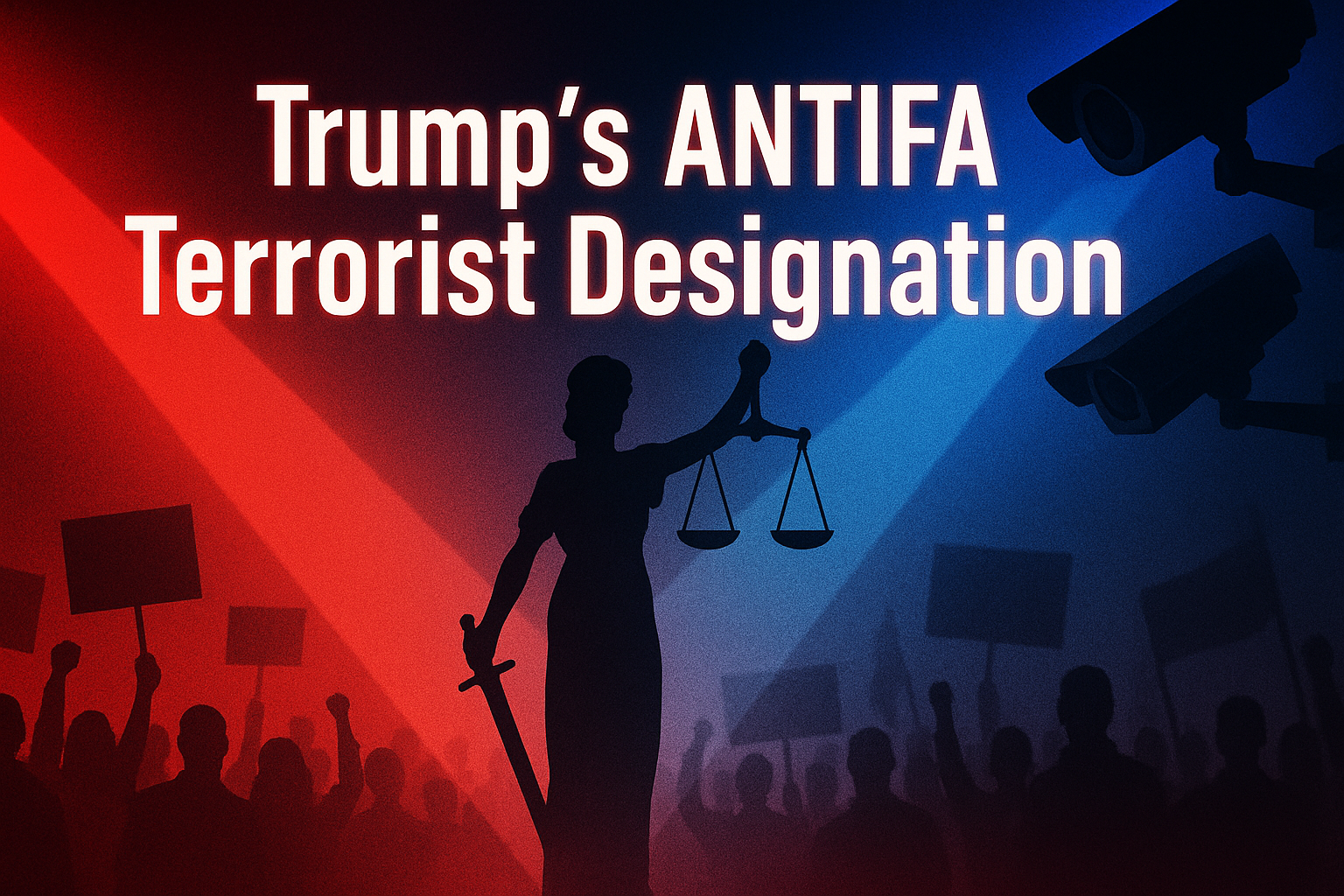
On September 17 2025, President Donald Trump reacted to the assassination of conservative activist Charlie Kirk by announcing that his administration would designate the antifascist movement known as “Antifa” as a terrorist organisation. In an interview with The Center Square he said he would “do that 100%,” adding that he had discussed Racketeer Influenced and Corrupt Organizations (RICO) charges with Attorney General Pam Bond. Trump insisted that Antifa was “terrible” and hinted that other radical groups might soon be targeted.
The declaration built on years of rhetoric. Since the early 2020s, Trump and allies have floated the idea of labeling Antifa a terrorist organisation, even though legal experts stress that U.S. law provides no mechanism for designating domestic groups as terrorists. Undeterred, Trump presented the new designation as a necessary response to a left‑wing terror network he believed was behind Kirk’s killing.
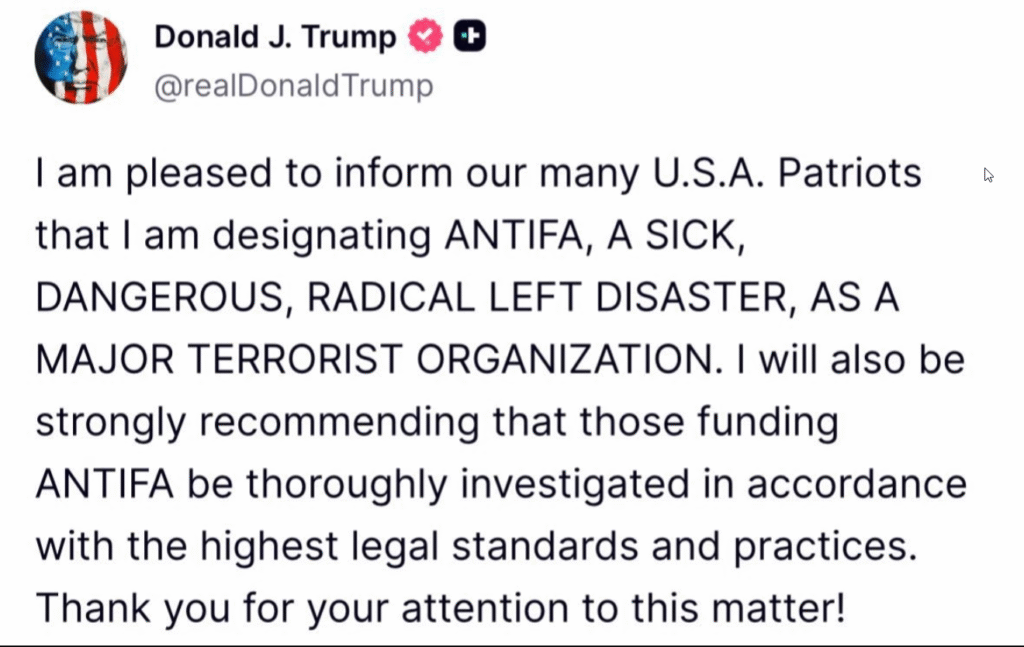
Charlie Kirk, co‑founder of Turning Point USA, was shot on September 10 2025 while speaking at Utah Valley University. Federal agents arrested Tyler Robinson, a 22‑year‑old student, after a 33‑hour manhunt. DNA evidence and recovered text messages implicated Robinson, who told friends he had an “opportunity to take out Charlie Kirk” and later destroyed a note outlining his plan. Utah Governor Spencer Cox described Robinson as holding increasingly left‑wing beliefs.
The killing sent shockwaves through right‑wing circles. Conservative commentators quickly framed it as evidence of a coordinated campaign of left‑wing terror. Former White House strategist Steve Bannon rejected the idea of a lone shooter and urged investigators to explore links between the murder and earlier attempts on Trump’s life. Online conspiracies flourished, with some pointing to an engraved bullet bearing an Italian antifascist slogan as proof of Antifa symbolism or to Tyler Robinson’s trans roommate.
Trump and his advisers quickly harnessed the tragedy. Deputy chief of staff Stephen Miller went on Kirk’s podcast and vowed to use the Department of Justice and Homeland Security to dismantle what he called a “terrorist network.” He said the administration would channel anger into action. Even before the arrest, Trump signaled he would “go after every radical left‑wing group” and warned that organizers or funders of protests could face federal racketeering charges. In Congress, Representative Anna Paulina Luna secured support to insert an Antifa designation into a State Department bill, citing Justice Department claims that antifa‑instigated violence in 2020 caused billions in damages.
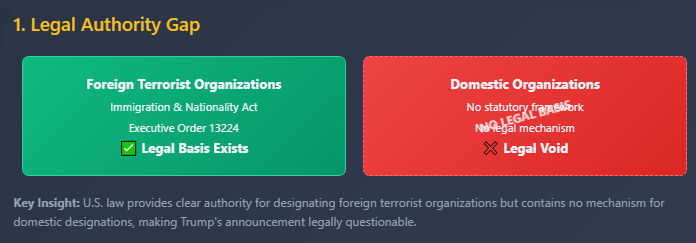
While Trump’s announcement evokes decisive action, U.S. law provides no authority to formally designate a domestic organisation as a terrorist group. Under the Immigration and Nationality Act, only foreign terrorist organisations (FTOs) can be designated; the authority is limited to entities abroad. Executive Order 13224 similarly applies to foreign persons or entities. Because Antifa is a diffuse, domestic movement, neither mechanism fits. Legal scholars note that no current legal authority exists for designating domestic organisations as terrorist organisations. Without statutory backing, any “designation” is largely rhetorical and carries no legal force.
Legal experts stress that only Congress could create a domestic terrorist designation. Mary McCord, former acting assistant attorney general for national security, warns that crafting such a law would immediately trigger First Amendment and due‑process challenges and would require clear criteria to avoid vagueness. The American Constitution Society reminds readers that counter‑terrorism tools in current law are aimed at foreign threats and cannot be repurposed for domestic opponents. Even some proponents of new legislation concede that any such statute would need safeguards to prevent abuse.
Scholars emphasise that Antifa is not a hierarchical organisation but a loose network of activists. The Center for Strategic and International Studies describes it as local chapters and individuals who coordinate informally and lack formal leadership. FBI Director Christopher Wray similarly testified that Antifa is an ideology rather than an organisation. Because it is a movement, designating it would be legally meaningless and practically unenforceable. Fact‑checkers have found no deaths attributed to antifa and warn that any domestic terrorism list would chill lawful protest. The Brennan Center notes that applying counter‑terrorism frameworks to protests undermines due process and assembly rights.
Historians also caution against mischaracterising the movement. Mark Bray describes antifa as a pan‑radical left coalition of communists, socialists and anarchists who primarily monitor and counter far‑right groups. He argues that the movement is often used as a scapegoat by politicians seeking to distract from underlying grievances. Misunderstanding this structure matters for enforcement: without membership rolls or leadership, there is no clear legal way to prove someone “belongs” to Antifa, making collective punishment untenable.
In the absence of a domestic designation, some conservatives propose using the Racketeer Influenced and Corrupt Organizations Act. RICO allows prosecutors to charge members of an enterprise if they commit a pattern of crimes affecting interstate commerce. A Homeland Security Affairs study argues that some antifa chapters have formed a national network that could satisfy RICO’s requirements, and commentators cite Senator Ted Cruz’s call for a RICO investigation. Critics counter that because Antifa lacks central leadership, proving an “association‑in‑fact” enterprise would be difficult and that using RICO against protest movements would chill speech and could be extended to other causes. The administration’s emphasis on RICO thus appears more rhetorical than practical.
RICO was originally designed to dismantle mafia syndicates and has occasionally been used against labour unions and activist groups. The Homeland Security Affairs thesis acknowledges that applying it to antifa would be unprecedented: prosecutors would need to show a pattern of predicate crimes linked by a common purpose. Some courts have recognised “association‑in‑fact” enterprises that are not corporations, but civil‑liberties groups warn that stretching the statute to cover ideological networks would set a dangerous precedent.
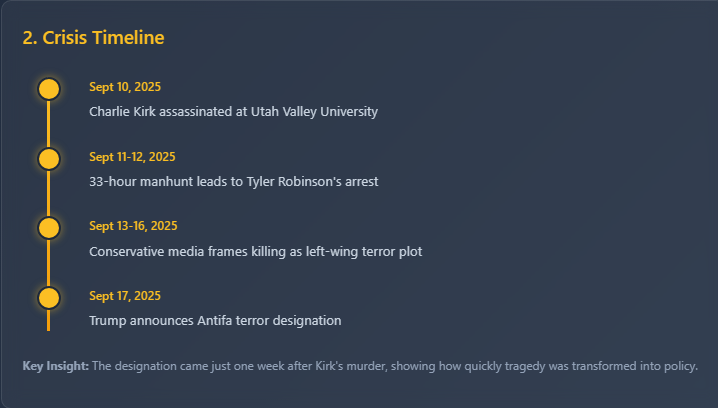
Right‑wing media and politicians portrayed the assassination as proof of an organised left‑wing terror campaign. Bannon’s War Room insisted there was a “vast conspiracy,” while Miller and Vance pledged to dismantle what they called a left‑wing extremist movement. The House fast‑tracked Luna’s bill to insert an Antifa designation into a State Department measure, arguing that Antifa‑linked violence during the 2020 riots caused billions in damages. Conservative think tanks urged the use of RICO and civil rights laws. Some rhetoric even suggested labeling the Democratic Party itself a “domestic extremist organisation,” escalating polarisation and encouraging stochastic terrorism.
On social media, hashtags such as #AntifaTerrorists trended as influencers connected Kirk’s murder to a broader left‑wing plot. Bannon and other commentators fixated on the engraved bullet bearing the antifascist song “Bella ciao,” presenting it as a smoking gun, and some even speculated about Chinese Communist Party financing. These claims, often unsupported by evidence, nonetheless shaped public perception and heightened demands for punitive action.
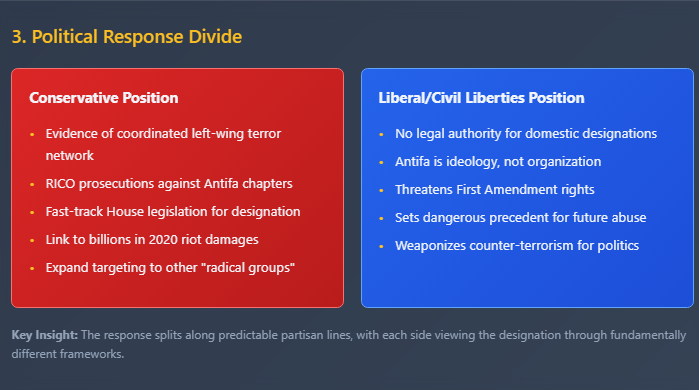
Democrats and civil‑liberties groups denounced the declaration as a political weaponisation of counter‑terrorism. Representative Greg Casar warned against using Kirk’s murder with a Mauser Rifle as a pretext to target peaceful opposition. The Brennan Center argues that applying terrorism frameworks to protests undermines due process and disproportionately harms marginalized communities, while the ACS notes that the FBI can already open investigations without evidence and that invoking terrorism would further expand surveillance. Critics also fear the designation could be used to fire people for social‑media posts and suppress dissent.
Left‑leaning media stress that political violence is not confined to one side. Observers point out that a 2024 assassination attempt on Trump and the murder of a Minnesota Democratic lawmaker and her husband illustrate how extremists on both the right and left have resorted to violence. Critics argue that focusing only on antifa‑linked actors risks ignoring the broader problem of political polarization and could justify suppressing opposition voices.
Coverage of the murder and the designation diverged along partisan lines. Conservative outlets portrayed the killing as proof of a coordinated terror network; progressive media warned of creeping authoritarianism. France24 reminded readers that Antifa is an umbrella term and that the U.S. maintains no domestic terrorist list. On social media, conspiracy theories proliferated, underscoring how tragedies become proxies for ideological battles.
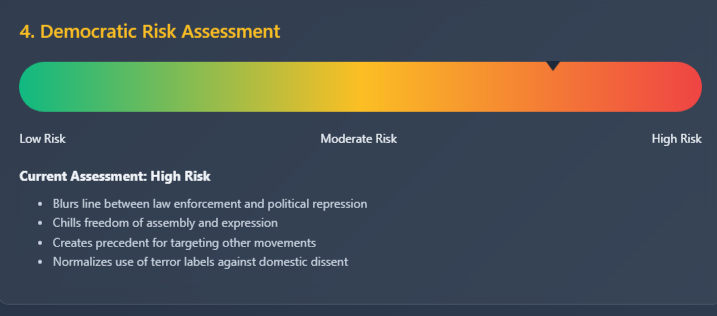
Branding a domestic movement as terrorism—especially without legal authority—blurs the boundary between law enforcement and political repression. A Just Security commentary warns that treating Antifa like al Qaeda or ISIS could allow authorities to label any protest organiser a terrorist. The ACS notes that the FBI already opens investigations without evidence; attaching a terrorism label would further expand surveillance. History offers caution: the FBI’s COINTELPRO program surveilled peaceful civil‑rights and anti‑war activists based solely on their beliefs.
Designating a diffuse ideology as terrorism risks chilling freedom of assembly and expression with freedom of speech already under threat after Jimmy Kimmel was taken off the air in the wake of comments about the Charlie Kirk assassin. The Brennan Center argues that applying counter‑terrorism frameworks to protests undermines due process and encourages militarised policing. Protesters may avoid demonstrations for fear of being labeled terrorists, and donors may hesitate to support activism. The ACS warns that expanding terrorism laws could be used against other movements, including pipeline protesters and environmental activists.
Labeling Antifa as terrorism sets a precedent for future administrations to target other movements. If a diffuse ideology can be branded a terror group, why not Black Lives Matter, climate activists or right‑wing militias? Such normalization could transform political disagreements into security threats and deepen polarisation. The Bridging Divides Initiative recorded hundreds of threats against officials in early 2025, suggesting that demonising movements may fuel further harassment and erode trust in law enforcement.
This second abstract illustration symbolises the tension between security and freedom. Equating dissent with terrorism may tip the scales toward safety at the expense of liberty, creating a feedback loop of repression and radicalization.
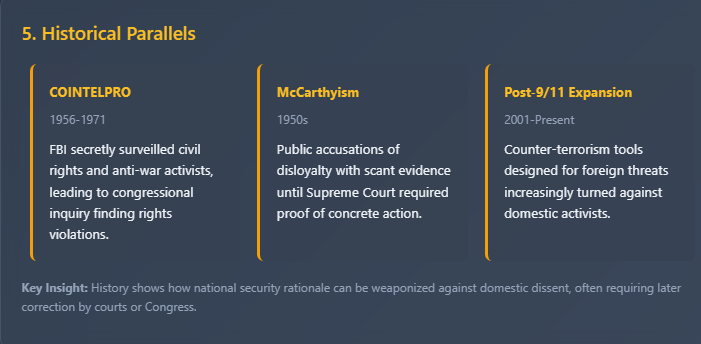
The United States has previously blurred the line between national security and dissent. During COINTELPRO (1956–1971), the FBI secretly surveilled and harassed civil‑rights and anti‑war activists, leading a later congressional inquiry to conclude that the government had violated rights. In the Second Red Scare, Senator Joseph McCarthy publicly accused people of disloyalty using unsavory methods. Many lost their jobs despite scant evidence until the Supreme Court required proof of concrete action to overthrow the government. These episodes show how state power can be weaponised against dissent.
The September 11 2001 attacks prompted a massive expansion of U.S. counter‑terrorism infrastructure; Just Security estimates spending at over $1 trillion. Tools designed to combat foreign terrorists have since been turned inward against domestic activists. The classification of U.S. citizens as enemy combatants, such as in the Jose Padilla case, shows how national security rationale can override constitutional protections. Trump’s attempt to label Antifa a domestic terrorist organisation could open similar doors to extralegal measures.
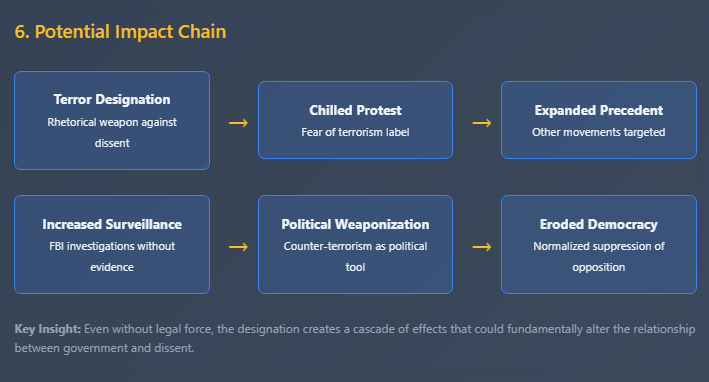
Trump’s declaration will likely face swift legal challenges. Civil‑rights organisations argue that there is no statutory authority for domestic terrorist designations and that the move violates the First and Fifth Amendments. Courts will need to decide whether the administration has effectively created a new category of domestic terrorism. Plaintiffs are expected to argue that branding a diffuse ideology as terrorism is vague and overbroad, reminiscent of earlier abuses. Should prosecutors pursue RICO, defendants can argue that Antifa lacks an enterprise structure and that their actions are protected speech. Even if a court accepts the RICO theory, any conviction would need to withstand appellate scrutiny on First Amendment grounds.
The House may insert an Antifa designation into a State Department bill, prompting debates over whether Congress should create a formal domestic terrorist list. Civil‑liberties groups warn that any list would chill activism and likely be struck down. Proposals to expand domestic terrorism laws face similar criticism: powers designed to combat jihadists could be turned against social movements across the spectrum.
Trump’s hard‑line stance may energise his base while galvanising progressives and civil‑liberties advocates. The issue will likely become a flash‑point in the 2026 midterm elections, forcing candidates to take positions on political violence and free speech. Pollsters expect the debate to divide voters along familiar lines—rural and conservative constituents supporting a crackdown, suburban moderates wary of government overreach, and progressive urban voters viewing the designation as authoritarian. Polarisation may deepen as each side accuses the other of enabling extremism or eroding liberties, further straining civic trust.
Labeling Antifa a terrorist organisation could inspire copycat designations against other movements. Conservative states might pursue terrorism prosecutions against climate activists; progressive prosecutors could target right‑wing militias. Once the terrorism label is normalized at home, foreign governments may feel emboldened to brand U.S. activists as terrorists, undermining America’s ability to criticise authoritarian regimes.
President Trump’s decision to designate Antifa a terrorist organisation following Charlie Kirk’s assassination marks a historic escalation in the politicisation of counter‑terrorism. Triggered by a shocking act of violence, the move taps into genuine fears about rising political extremism but proposes a solution unsupported by existing law. Experts across the spectrum agree that the United States lacks a legal process for designating domestic groups as terrorist organisations. Antifa itself is not an organisation, but a diffuse movement; labeling it as a terrorist group will therefore have little practical effect on crime while giving the government a potent rhetorical weapon.
The main impact of the designation is political. It allows the administration to cast a wide ideological net, conflating dissent with terrorism and mobilising its base against a vilified “enemy within.” Conservative media and politicians have seized on Kirk’s murder to call for extraordinary measures, including RICO prosecutions and firings over social‑media posts. Meanwhile, civil‑liberties advocates warn that the move threatens free speech and sets a precedent for targeting other movements.
History warns against equating dissent with subversion. Past episodes like COINTELPRO and McCarthyism illustrate how state power can be abused to suppress political opponents. The Supreme Court eventually reaffirmed that advocacy—even of radical ideas—is protected unless paired with concrete plans for violence. America faces a dual challenge: combating genuine threats of political violence while safeguarding democratic freedoms. Responding to murder with authoritarian innovations risks eroding the very liberties that define the nation. The coming legal battles, legislative debates and political campaigns will determine whether the United States recommits to the rule of law and civil liberties or normalises the use of terror labels to silence dissent.
| Source and citation | Key information | Confidence |
|---|---|---|
| Salem News (Center Square interview) | Trump said he would “100%” designate Antifa a domestic terror organisation, mentioned House bill and discussed RICO charges with Attorney General Bondi; article notes House leadership supported inserting the designation into a State Department bill. | High – direct quotes and legislative details. |
| France24 | Stephen Miller vowed to dismantle a “terrorist network” linked to Kirk’s murder and promised to use DOJ and DHS resources; report notes Antifa is an umbrella term and that there is no domestic terrorist list. | High – attributed to official statements; provides context. |
| Al Jazeera | Detailed Kirk’s murder (DNA evidence, text messages, left‑wing ideology); reported Trump’s pledge to bring RICO charges and designate Antifa; quoted J.D. Vance urging firing of those who celebrated Kirk’s death; quoted Representative Greg Casar warning against using the murder to target opposition. | High – factual reporting with named sources. |
| National Desk | Quoted Steve Bannon claiming the shooter did not act alone and urging investigators to probe Antifa links and connections to a previous assassination attempt on Trump. | Moderate – includes speculation alongside quotes. |
| Telegraph | Summarized Bannon and MAGA figures dismissing the lone‑assassin theory; noted calls for Antifa to be designated a domestic terrorist organisation; described bullet engraved with “Bella ciao” and alleged Chinese involvement. | Moderate – accessible excerpts; partial due to paywall. |
| CSIS | Described Antifa as a decentralized network of far‑left activists without formal leadership; warned that designating Antifa as a terrorist organisation would raise First Amendment issues and be difficult to enforce; noted limited size and focus on countering far‑right groups. | High – independent research. |
| FactCheck.org | Highlighted absence of deaths attributable to antifa; explained that there is no legal process for domestic terror designations; warned that creating such a list would chill free speech. | High – fact‑checking site citing legal experts. |
| ACS legal analysis | Explained that FTO designations and executive sanctions apply only to foreign threats and cannot target Antifa; warned that terrorism labels invite overbroad surveillance and can be used against other movements like pipeline protesters; noted that the FBI already operates under guidelines allowing investigations with no factual predicate. | High – authored by law professor. |
| ACLU on COINTELPRO | Documented how the FBI’s COINTELPRO program surveilled and harassed peaceful protest groups based on political beliefs; the Church Committee concluded the government targeted citizens without evidence. | High – historical reference. |
| First Amendment Encyclopedia (McCarthyism) | Defined McCarthyism as publicly accusing people of political disloyalty using unsavory methods; reported that many lost jobs despite scant evidence; noted that the Supreme Court’s Yates decision required proof of concrete steps toward overthrowing the government, curtailing McCarthyism. | High – educational source. |
| Just Security article | Noted that post‑9/11 counter‑terrorism spending exceeded $1 trillion; warned that labeling Antifa a domestic terrorist group would be unprecedented and would criminalise dissent; argued that anyone participating in protests or sharing memes could be labeled a terrorist. | High – commentary by national security security scholars |